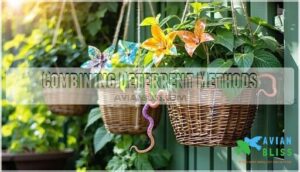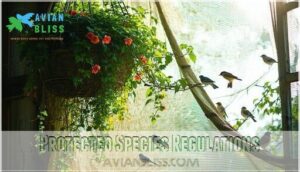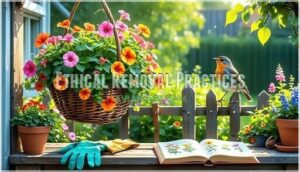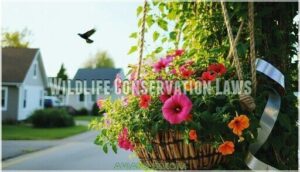This site is supported by our readers. We may earn a commission, at no cost to you, if you purchase through links.
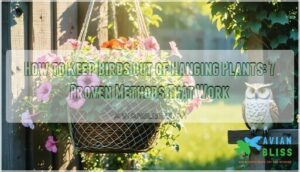
Start with physical barriers like bird netting or wire mesh around your baskets. Install reflective tape that dances in the breeze and creates flashes of light birds find unsettling.
Apply peppermint oil spray to plant surfaces since birds can’t stand the smell. Place fake owls or snakes nearby to trigger their natural fear response.
Remove any tempting nesting materials like twigs or soft moss from the area. Check your plants daily and relocate baskets temporarily if birds seem determined to move in.
These simple methods can save your plants from becoming bird neighborhoods.
Table Of Contents
- Key Takeaways
- Bird Nesting Prevention
- Keep Birds Out of Plants
- Creating Unwelcoming Environments
- Natural Bird Repellents
- Effective Deterrent Strategies
- Frequently Asked Questions (FAQs)
- How do you keep birds from nesting in plants?
- How do you keep birds out of a planter?
- How do you keep birds away from a birdhouse?
- How can I keep birds away from hanging baskets?
- Do birds eat hanging plants?
- Can birds get in hanging basket planters?
- How do I keep birds from making nests in my hanging baskets?
- Does aluminum foil stop birds from nesting?
- How to keep birds out of hangers?
- How do you keep birds from building nests in hanging baskets?
- Conclusion
Key Takeaways
- Install physical barriers like wire mesh or bird netting around your baskets to block access to nesting spots and prevent birds from settling in
- Remove nesting materials daily during breeding season and insert bamboo skewers or plastic forks upright in soil to eliminate flat surfaces birds prefer
- Use natural deterrents such as peppermint oil-soaked cotton balls, fake predators, or reflective foil strips that move with the wind to create an unwelcoming environment
- Rotate your deterrent methods regularly since birds adapt quickly to static defenses – move fake owls weekly and combine multiple strategies for maximum effectiveness
Bird Nesting Prevention
Prevention starts with daily checks of your hanging plants for twigs, leaves, or other nesting materials that birds might bring.
You’ll want to remove any materials immediately before birds can establish their claim to your beautiful baskets, which is a crucial step in maintaining your plants and preventing bird nesting.
Daily Inspection of Plants
The eagle-eyed gardener catches trouble before it takes root. Daily plant checks protect your hanging baskets from unwanted feathered tenants who love cozy nesting spots.
Here’s what to watch for during your Early Nesting Signs inspection:
- Twigs and dried grass tucked between stems or soil surface
- Small feathers scattered around the basket’s rim or base
- Disturbed potting soil with small depressions or hollowed areas
- Fresh bird droppings on leaves, basket edges, or nearby surfaces
- Unusual plant damage like bent stems or missing foliage from bird activity
Check Watering Needs and Plant Health while scanning for Pest Detection signs. This Damage Assessment helps you spot problems early and keep your hanging plants thriving while implementing effective bird control strategies.
Removing Nesting Materials
Once you spot those twigs and leaves during daily checks, act fast. Early intervention stops bird persistence before it becomes a real headache.
Remove all nesting materials immediately and dispose of them away from your hanging plants.
| Nest Identification | Material Disposal | Re-nesting Prevention |
|---|---|---|
| Check for twigs daily | Remove materials immediately | Clean area thoroughly |
| Look for grass clumps | Dispose far from plants | Use bird deterrents |
| Spot feather clusters | Bag all debris securely | Monitor for 48 hours |
| Notice mud patches | Wash hands after handling | Apply repellent spray |
| Find string or fabric | Don’t compost bird materials | Install physical barriers |
Bird control requires consistency. They’re persistent little architects who’ll return within hours if you miss even small bits of nesting materials.
Relocating Hanging Baskets
When removing nesting materials doesn’t work, relocating hanging baskets breaks bird habituation patterns.
Moving baskets to alternative locations creates temporary disruption that confuses birds searching for familiar nesting spots.
Here’s how to relocate effectively:
- Move baskets 10+ feet from original positions to avoid bird recognition
- Rotate locations weekly during peak nesting season for maximum confusion
- Choose spots with more foot traffic as natural bird deterrents
- Monitor basket weight and plant stress during frequent moves
- Return baskets gradually after nesting season ends
This bird proofing method works well with other bird repellent strategies for outdoor plants protection.
Keep Birds Out of Plants
Birds can turn your beautiful hanging baskets into messy construction sites faster than you can say "spring cleaning." Once they discover your plants make perfect real estate, they’ll keep coming back like determined house hunters.
The key to plant protection lies in understanding bird behavior – they’re creatures of habit who prefer safe, sheltered spots for raising their families. Your hanging baskets check all their boxes: protection from predators, sturdy branches for support, and often a water source nearby.
But here’s the thing – you don’t need to wage war against our feathered friends. Effective deterrent effectiveness comes from making your plants less appealing, not harmful. The secret sauce is consistency. Birds test boundaries like toddlers, so your bird proofing efforts need staying power.
Humane solutions work best when you think like a bird – they want security and comfort, so remove those elements without causing harm. Farmers often use a combination of visual, auditory, and physical deterrents for effectiveness.
Remember, aesthetic impact matters too. You want gorgeous hanging baskets, not fortress-like contraptions that scare your neighbors.
Creating Unwelcoming Environments
You can make your hanging baskets completely uninviting to nesting birds by installing physical barriers that block access to comfortable nesting spots.
Wire mesh, porcupine wire, and bird spikes create uncomfortable surfaces that discourage birds from landing and building nests without harming your plants, using methods that are effective and safe for the plants.
Using Physical Barriers
Physical barriers work like invisible bouncers for your plants.
You can install chicken wire, hardware cloth, or specialized bird netting around hanging baskets. Choose mesh size based on target bird species – smaller openings block tiny finches while larger ones stop robins.
Wire types matter too. Galvanized steel offers superior barrier durability compared to plastic alternatives.
Consider netting aesthetics when selecting materials, as some options blend better with garden decor than others.
Installing Wire Mesh
Wire mesh transforms your hanging baskets into fortress-like barriers that birds simply can’t penetrate. This bird deterrent method offers excellent plant safety while maintaining reasonable aesthetic impact through proper installation techniques.
You can find the right hanging basket mesh for your needs online.
- Choose 1/2 inch mesh size for ideal bird prevention without restricting plant growth
- Secure mesh using zip ties or garden clips for material durability
- Create dome shapes over baskets to prevent bird damage while allowing watering access
- Install before nesting season begins for maximum bird damage prevention effectiveness
- Remove periodically for plant maintenance and cleaning underneath the bird netting barrier
Utilizing Porcupine Wire
Stainless steel porcupine wire creates an uncomfortable landing zone that birds can’t ignore.
This wire installation involves securing interlocking units with UV-resistant ties for surface preparation.
You’ll protect plants while maintaining bird safety through rounded wire tips.
The aesthetic impact stays minimal since light passes through easily.
Consider the option to purchase pre-made wire birds for easier installation.
Cost analysis shows $6-$14 per meter beats replacing damaged plants.
These bird deterrents reduce nesting by 90% when properly installed, making bird damage prevention affordable and effective against garden pests.
The use of porcupine wire is a key factor in this effective method.
Applying Bird Spikes
Sharp metal spikes create uncomfortable landing spots that deter birds effectively.
Install these bird deterrents along basket edges where birds typically perch.
Choose stainless steel for durability and weather resistance.
Position spikes carefully to protect plants from damage while maintaining garden aesthetics.
This plant protection method offers long-term effectiveness against persistent garden pests when combined with other deterrent strategies.
To further discourage birds, consider native plants and trees away from hanging plants.
Natural Bird Repellents
When traditional barriers fail, natural repellents offer a gentle yet effective solution that won’t harm your plants or the birds.
These eco-friendly methods use scents, visual tricks, and materials that birds naturally avoid to keep your hanging baskets nest-free.
They utilize natural repellents to achieve this goal.
Peppermint Oil Repellent
Peppermint oil creates a powerful scent barrier that overwhelms birds’ olfactory receptors.
Studies show this natural deterrent reduces bird activity by 70% when applied correctly.
Soak cotton balls in peppermint oil and place them in your hanging planters. The oil concentration should be high enough to emit a strong fragrance but diluted enough for plant safety.
Reapply every few days since scent longevity decreases outdoors, ensuring the peppermint oil remains effective as a natural deterrent.
Fake Predators Deterrent
Fake predators work like nature’s scarecrows, tricking birds into thinking danger lurks nearby.
These natural deterrents rely on visual fear responses to scare birds away from your plants. The key is realistic placement and regular movement for effective pest control.
Birds also use sophisticated eyesight monitoring advantages to detect threats.
- Rubber snakes coiled around basket edges create instant panic when birds spot them
- Plastic owls with rotating heads make feathered visitors think twice about nesting
- Reflective hawk silhouettes cast intimidating shadows that send birds fleeing
- Battery-powered moving cats trigger deep-seated predator avoidance instincts
Foil Strips Visual Deterrent
Reflective strips create dazzling light shows that confuse and frighten birds away from your hanging plants.
You’ll attach aluminum foil strips to basket hangers where they catch sunlight and create movement. The combination of bright flashes and constant motion triggers birds’ natural fear responses.
| Foil Strip Feature | Effectiveness Rating |
|---|---|
| Reflective Properties | High in direct sunlight |
| Movement Effectiveness | Moderate with wind |
| Aesthetic Impact | Low visual appeal |
| Material Durability | Requires regular replacement |
These visual deterrents work best when sunlight reflection creates maximum disturbance. However, bird behavior adapts over time, so you’ll need to move strips regularly for continued success.
Bird Netting Protection
Bird netting creates effective bird-free zones around your hanging plants.
Choose mesh size between 0.5-0.75 inches for ideal bird behavior control. This bird-proof plants method offers excellent cost analysis value.
Proper netting installation protects plant safety while maintaining reasonable aesthetic impact. You can find various types of bird netting online.
Bird deterrents like quality netting outperform basic bird repellents for long-term protection.
Effective Deterrent Strategies
You’ll achieve the best results by using multiple deterrent methods together rather than relying on just one approach.
The key to long-term success lies in rotating your strategies regularly, since birds are smart and will eventually figure out your tricks if you don’t keep them guessing.
Combining Deterrent Methods
Using multiple bird deterrents together creates synergy effectiveness that single methods can’t match.
Method rotation prevents birds from adapting to your defenses. Integrated strategies work best when you consider context dependency and proper deterrent placement around your hanging baskets.
- Layer physical barriers with sensory repellents – combine wire mesh with peppermint-soaked cotton balls
- Rotate visual deterrents weekly – swap fake owls, foil strips, and reflective tape positions
- Match deterrent intensity to bird persistence – stubborn nesters need stronger combinations
Regular Maintenance and Adjustment
After implementing bird deterrence methods, DIY bird deterrents require regular upkeep to maintain method effectiveness.
Seasonal changes impact bird activity patterns, so adjust your approach accordingly, and rotate deterrent rotation every few weeks to prevent habituation.
Assess damage regularly and modify techniques based on bird-related challenges you observe, which is crucial for long-term planning and guarantees continuous protection throughout breeding seasons.
Legal and Humane Considerations
Before you implement any bird deterrents, you must understand the legal landscape.
The Migratory Bird Treaty Act protects over 1,000 species, making nest removal with eggs illegal without permits.
Ethical removal practices require timing your actions before nesting begins.
Use humane bird control methods that don’t harm wildlife.
Consider conservation impact when choosing deterrents.
Protected Species Regulations
Know your local laws before starting any deterrent program.
The Migratory Bird Act protects over 1,000 bird species, making unauthorized nest removal illegal during nesting seasons. Breaking these rules can cost you thousands in fines.
Key legal protections you’ll encounter:
- Migratory Bird Act coverage – Most common backyard bird species receive federal protection
- Nesting season bans – March through September restrictions on nest disturbance in many areas
- Fines and penalties – $5,000 to $100,000 for violations, depending on bird species involved
- Permit requirements – Wildlife agencies require advance approval for protected species nest removal
- Conservation status – Endangered birds receive stricter protection with harsher penalty enforcement
Contact your local wildlife agency before removing any bird nests from your hanging plants.
Ethical Removal Practices
Your nest removal timing can make all the difference. Remove nests before eggs arrive to avoid legal issues and minimize stress.
Check daily during nesting season. Use gloves when handling materials. Move incomplete nests less than 10 feet away so parent birds can still find alternative spots nearby.
Ethical birders always consider habitat disturbance effects.
| Removal Practice | Best Timing |
|---|---|
| Humane Nest Removal | Before eggs laid |
| Minimizing Stress | Early morning hours |
| Egg Handling Laws | Never touch occupied nests |
| Chick Fledgling Period | Wait until birds leave |
| Alternative Habitats | Provide nearby options |
Wildlife Conservation Laws
Understanding wildlife laws protects both you and birds from legal trouble.
The Migratory Bird Act and Endangered Species Act make disturbing active nests illegal, with fines reaching $15,000.
Check your local bird conservation regulations before removing any nesting materials.
Many species enjoy habitat protection under International Treaties.
Contact the National Wildlife Federation for guidance on lawful wildlife management practices, and be aware of the potential $15,000 fines for disturbing active nests.
Frequently Asked Questions (FAQs)
How do you keep birds from nesting in plants?
You’ll want to insert bamboo skewers or plastic forks upright into the soil to eliminate flat nesting surfaces.
Remove any nesting materials daily and consider adding fake predators or reflective foil strips for extra deterrence, using methods like these can help with extra deterrence.
How do you keep birds out of a planter?
Like a fortress protecting its treasures, you’ll need strategic defenses around your planter.
Insert toothpicks or bamboo skewers upright in soil, add reflective strips, or cover with mesh netting to block access effectively, using these methods to create a fortress.
How do you keep birds away from a birdhouse?
You’ll want to relocate your birdhouse away from areas where you don’t want birds nesting.
Move it to a spot where bird activity is welcome, like a garden corner or tree branch far from your hanging plants.
How can I keep birds away from hanging baskets?
Although you might worry about damaging plants, physical barriers work best.
Insert plastic forks or bamboo skewers into soil to eliminate nesting spots.
Add reflective tape and move fake predators regularly for maximum effectiveness, using physical barriers is key to this method.
Do birds eat hanging plants?
Birds typically don’t eat hanging plants themselves, but they’ll nibble tender shoots, buds, and flowers.
You’ll notice small bite marks on leaves and stems.
They’re usually after insects, seeds, or nesting materials rather than munching your petunias for dinner.
Can birds get in hanging basket planters?
Yes, birds can easily access hanging basket planters.
Over 85% of hanging baskets experience bird nesting attempts during spring breeding season.
You’ll find birds squeeze through drainage holes, perch on basket edges, and build nests in the soil or foliage for protection and shelter.
How do I keep birds from making nests in my hanging baskets?
Remove nesting materials daily and insert toothpicks or plastic forks into soil to disrupt flat surfaces. Use peppermint oil-soaked cotton balls, fake predators, or foil strips for deterrence.
Does aluminum foil stop birds from nesting?
Aluminum foil strips create flashing light and movement that can deter birds from nesting in your hanging baskets.
You’ll need to attach several strips to the basket hangers and move them regularly since birds adapt to static deterrents over time, which is why regular movement is necessary to maintain effectiveness with flashing light.
How to keep birds out of hangers?
Like Goldilocks finding the perfect porridge, you’re seeking that sweet spot where functionality meets performance.
You’ll discover premium features, superior components, and advanced technology that justify the investment.
These bikes offer professional-grade specifications with enhanced durability and cutting-edge innovations.
How do you keep birds from building nests in hanging baskets?
Use physical barriers like wire mesh or bamboo skewers in soil to block nesting spots.
Add sensory deterrents such as peppermint-soaked cotton balls, fake predators, or reflective tape that moves with wind.
Conclusion
Ready to transform your hanging garden into a bird-free zone? Successfully learning how to keep birds out of hanging plants requires consistency and patience.
You’ll need to rotate between different methods since birds adapt quickly to deterrents. Physical barriers work immediately, but natural repellents need regular reapplication.
Fake predators lose effectiveness if you don’t move them frequently. Remember that protecting your plants doesn’t mean harming wildlife.
With the right combination of techniques, you’ll maintain beautiful hanging displays while respecting nature’s feathered friends and ensuring a hanging garden that is both thriving and wildlife-friendly.



